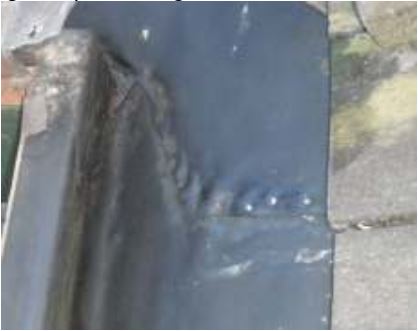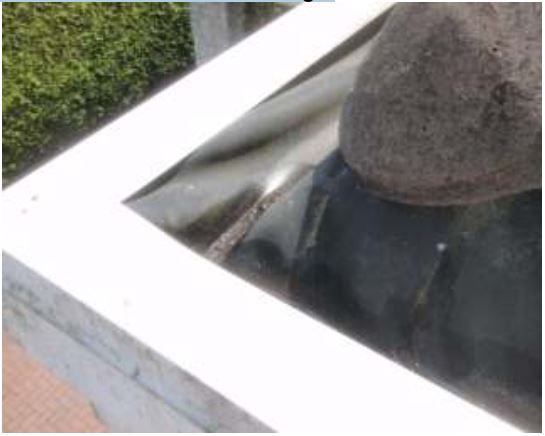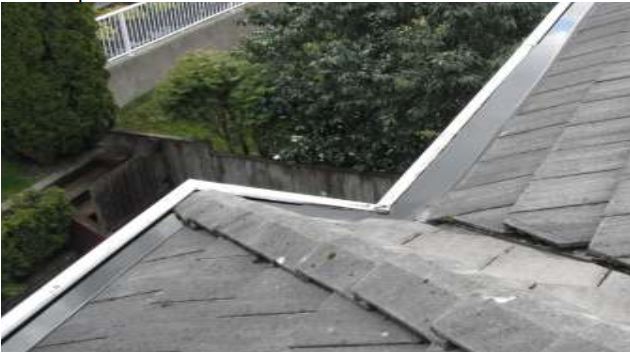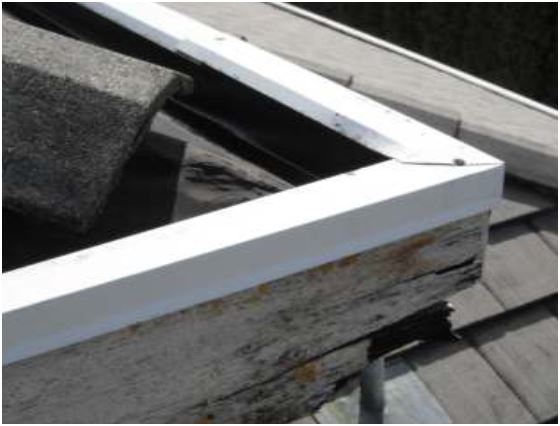Blog
The Trouble With Built in Gutter Systems
Many homes around the lower mainland are constructed with “Built in” or “Hidden
Gutter” systems in lieu of traditional aluminum or metal eaves trough. This style
is chosen for various reasons and aesthetics is one of the big ones, as many
prefer the clean appearance of the built in system and its incorporation with the
fascia boards of the home.
The built in systems are typically installed in with two types of membrane
• SBS or torch on membrane
• EPDM or rubber membrane.
The EPDM system is the most common system currently installed, however it is
also the most common system not to be installed to accepted roofing (or any)
standards.
What are the issues:
Poor details at corners and seams – these details are rarely done correctly.
Often laps are incorrectly sealed with staples and caulking or roofers mastic.
All membrane seams should be patched with uncured EPDM membrane flashing, the
gutter liner itself is a cured membrane and is forced to form into the shape of
the gutter even though the membrane shape is already set, if these detail are completed only with adhesive (even if it is the right kind ) or caulking, these locations are doomed for failure. Installing uncured membrane at these locations allows the rubber patch to cure in the shape of the gutter preventing failed seams down the road.
Incorrectly Installed Drains – Drains are often incorrectly nailed either on
top of the membrane and sealed with a caulking or roofers mastic, some are
installed under the primary membrane with the membrane glued to the top –
better, but still problematic, and will eventually fail and can cause damage to the structure.
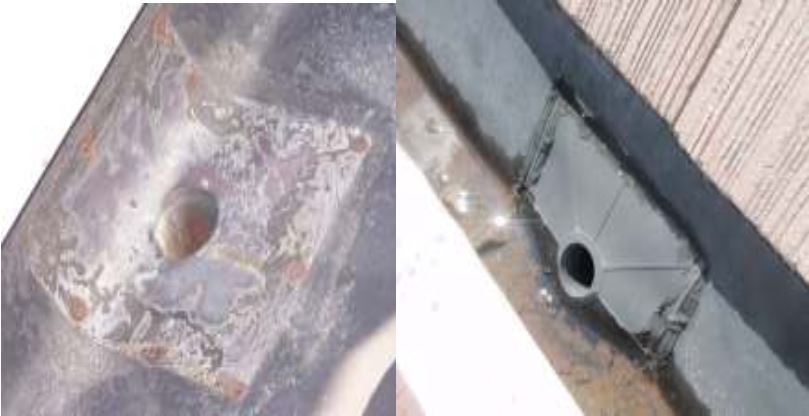
The EPDM is loose laid – not secured or bonded to the substrate. This
creates problems at drain and seam locations. With age the EPDM
membrane will shrink causing it to pull across corners seams and drain
locations, which will stress seam and drain locations and cause leaks, and damage to the structure.
Tenting of the membrane is also a problem associated with this, which will
decrease gutter capacity and inhibit effective flow to the drains. A properly
installed membrane should be bonded to the substrate and mechanically
fastened on the upper edge overlapped by the installed roofing, and to the
fascia on the outside vertical edge.
The EPDM is the wrong size – It is common on many installations that the
membrane is terminated at the top horizontal edge of the fascia board and is often
tacked there with small staples. This creates a problem, the first
being that the membrane has been penetrated with staples causing multiple
tiny holes on a horizontal surface that will pond water and eventually leak
through the holes and rot the substrate. The membrane should extend
down the vertical outside surface of the fascia so any moisture has an
efficient path of drainage to the ground, and creating a complete waterproof envelope over the critical surfaces.
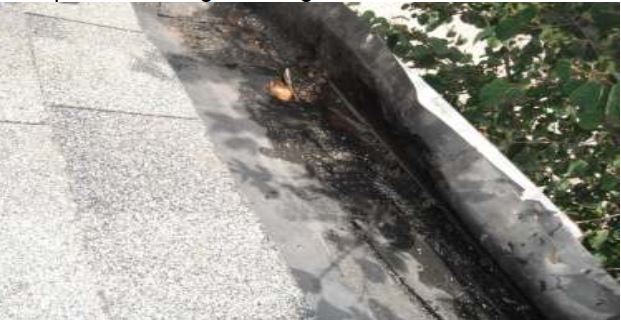
Poor Membrane Quality – SSome “EPDM” gutter liners are of inferior quality
and are blended with vinyl or other additives that are not compatible with
many EPDM products, and make it difficult to seal drains and seams.
Poor Drainage locations – Drains are often installed in locations where the
Rain Water Leader or downpipe is the least visible for aesthetic purposes.
This however causes functional problems as drains will be hidden on the
sides of homes leaving entire elevations without drainage. This results in a
large volume of water that cannot access the drain efficiently due to corners,
or tented membrane obstructing the flow, which will cause further problems.
The added weight of the water in the gutter will cause the gutter structure to
settle leaving the drains in the high point which creates more problems down
the road. Re sloping the substrate, and/or adding more drainage are
remedial options in these situations.
Insufficient Gutter Depth – Some gutter profiles are constructed with
insufficient depth to accommodate all water from the roof system and hold it
until it has a chance to drain from the system. This condition can be
remedied by installing additional wood blocking to the top of the outside
fascia, and splice a membrane extension to extend the membrane down the
outside vertical face of the fascia board a minimum of two inches or as the
metal flashing allows.
Poor Metal Flashing Details – The vast majority of perimeter metal cap
flashings installed in conjunction with built in gutter systems are not installed
to accepted roofing standards. Most are a very light 28-gauge metal. The
pieces are installed with un-caulked lap seams and top nailed with common
roofing nails, which allows water to enter into and under the membrane at the
flashing joints and fastener locations, causing expensive rot replacement
down the road. Perimeter flashings installed to accepted standards would
consist of heavier 26 gauge prefinished metal, installed with sealed s-lock
joints, and standing seam corners, secured to the structure at out side vertical
locations.
So now we know what’s wrong – How Do We Fix Them?
RooFix is the industry leader in remediation of built in gutter systems
offering a variety of repair options to fit every budget.
Bronze Level – 5 year warranty – Our most cost effective solution – Repairs the
worst offenders (drains, seams and transition details) and offers a economical
alternative to flashing replacement and membrane extension
– Replacement of all existing gutter drains with new 2” aluminum drains installed
to RooFix specifications. After removing the existing drain we repair the damaged
membrane location with new full bonded cured EPDM rubber. A new 2” aluminum drain
is mechanically fastened over the repaired membrane location with 8 -1¼” specialized
membrane fasteners, and a pressure sensitive sealant installed between the new drain
flange and the base membrane as a secondary barrier. Over the secured and sealed
drain a new fully bonded.045 mil uncured EPDM membrane patch is installed over the
new drain flange and laps a minimum of 3” onto the existing base membrane providing a
complete sealed unit. (ask about our upgrade to larger capacity 3” drains with ground
level debris traps)
– Repair of all seams, corners, and gutter/roof transition points. All existing
membrane inside and outside corner laps, seams, and gutter to roof transition points are
cleaned, and any nails in the seam removed. Firestone poly batten is installed over the
membrane and fastened through the membrane securing it to the substrate every 6”. An
uncured .045mil EPDM patch is then fully bonded to the detail location.
– Perimeter Metal Flashing is refastened and Sealed. Existing top mounted fasteners
are removed and replaced with prefinished neoprene gasket screws, metal laps and
seams are cleaned and new sealant installed between the laps.
– All Debris Removed From Gutter System upon completion of work all organic and
repair debris will be cleaned from the gutter system. Cleaning of the entire roof system
is recommended with this package but not included as part of the gutter price unless
specified.
– Gold Level – 10 year warranty – Our top of the line system – Guaranteed to give your home the protection it deserves!
– Complete removal of existing gutter membrane and flashing the complete gutter
liner, drains and flashings will be removed and recycled accordingly, and the substrate
prepared to accept the new system.
– *Optional – Slope correction – We add new framework and sheathing, or tapered
insulation packs onto the existing system to create positive slope to the drain locations.
– New .060 mil Firestone EPDM rubber membrane installed. New .060 EPDM
membrane is fully bonded to the substrate, the new membrane extends up the roof slope
under existing roof covering and down the outside vertical face of the fascia board a
minimum of 2 “, the top edge , and outside face of the membrane are mechanically
secured to the structure with new fasters at 6” o.c. spacing.
– New 2” aluminum gutter drains are installed to RooFix Specifications. A new 2”
aluminum drain is mechanically fastened over the new membrane location with 8 -1¼”
specialized membrane fasteners, and a pressure sensitive sealant installed between the
new drain flange and the base membrane as a secondary barrier. Over the secured and
sealed drain a new fully bonded .045 mil uncured EPDM membrane patch is installed
over the new drain flange and laps a minimum of 3” onto the existing base membrane
providing a complete sealed unit. (ask about our upgrade to larger capacity 3” drains
with ground level debris traps)
– All corners, Seams, and Gutter/roof Intersects sealed. All existing membrane
inside and outside corner laps, seams, and gutter to roof transition points are cleaned
and an uncured .045mil EPDM patch is then fully bonded to the detail location extending
a minimum of 3” past either side of the seam.
– New Prefinished 26 gauge perimeter Cap Flashing installed. We supply and install
new quality made prefinished 26 gauge metal perimeter cap flashings secured on outside
vertical surfaces with s-locked joints and standing seam corners done to accepted roofing
standards. Multiple colour choices available.
– All Debris Removed From Gutter System. Upon completion of work all organic and
repair debris will be cleaned from the gutter system. Cleaning of the entire roof system is
recommended with this package but not included as part of the gutter price unless
specified.
article: Sean Pepin RRO
